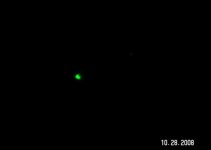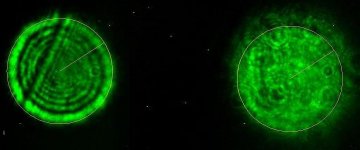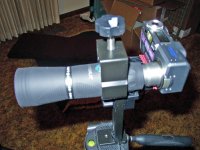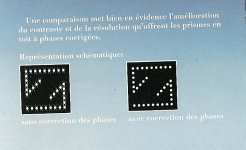Surveyor
The more I understand, the more I understand why I
Ed;
I should mention that I just bought the Barska a short time ago with a specific purpose in mind, for photos of some tests that may be posted and another project that I am working on that require a specific type of image. I did not expect it to be of the same quality of my usual boosters. I normally test with the best optic I have that gives me the magnification needed for the specific test under way.
I just did a quick star test of the Barska 10x40 monocular using the Promaster as the booster. I did try to photograph the results, but just to difficult to get everything lined up on a 500-micron exit pupil. I never did get an image on the camera.
The inside focus pattern was very impressive. Better than the Promaster. It showed very clean, perfectly circular diffraction rings (about 8 waves) with no discernable errors in lower order coma, alignment, astigmatism or pinch. The notable feature was a far brighter center ring than normal. Also, without the green filter in place there was a very bright, broad purple ring outside the outer diffraction ring indicating a high level of CA.
The in focus image was another story. There were three or four diffraction rings surrounded by a broad ring of cotton candy. The diffraction rings in the center were very bright. The cotton candy stuff was split into two hemispheres and judging by the angle of the split, may have been along the roof edge. The in focus image was observed at 80x.
The extra focal image was just a very bright center spot surrounded by a broad area of cotton candy.
My interpretation is that the Barska suffers mostly from higher order errors, mostly high order minus SA. My guess is that the higher order errors amount to about one wavelength. Kimmo or Henry may want to correct this assessment due to their high experience level and I would welcome that.
I have attached photos of the left tube Promaster tests with the Barska as the booster. Note the even light intensity across the patterns. Also note the in focus image. This was taken at about 240x magnification. The outside focus shows –SA of, maybe, 1/3 wavelength, part of which may be the 11 meter test length and since the in focus image was so good I think the test indicates less than 1/3 wave error and probably close to diffraction limited. Since I see –SA in most binoculars, I wonder if this is how the manufacturers add field curvature to control the rolling ball effect. Not being an optician, I have no idea how that is added.
BTW, what I term cotton candy is an indescribable indistinct image as shown in the Promaster extra focal image attached.
Alexis;
I think your points are very much on target and routinely overlooked. I just started star testing in the recent past but have found it to be an extremely reliable indicator of quality and easy to judge differences between units. So far all of my results have been confirmed by other measurements or visual perception in use. My experience is limited and Henry and Kimmo may weigh in, their experience level is vastly greater than mine.
As you suggested, when I started testing this way, I had the same concerns as Ed. I used several different boosters and tested several of my old reliable bins with 3 or 4 of them. My usual boosters are a 6x30 inverted image double collimator with fixed infinity focus of very good commercial test equipment quality and is my favored booster due to the 5 arc minute grid to measure apparent angle. My second best is the 8x20 Ultravid but not used often because of mounting. The other commonly used are an 8x20 Zeiss Monocular, a Zeiss 3x tripler and various commercial dioptometers and other optical measuring devices.
My Leica 8x32BA has been tested with all of the above and some others as well. It was my practice instrument and my reference bin. So far the star tests have been consistent with all the different boosters used. I have not tested with the Barska but will do that in the near future. My 8x20 Ultravid has been tested with multiple boosters also.
EDIT: I just noticed Henry’s post and I think the middle paragraph covers all the bases for me.
Best to all.
Ron
I should mention that I just bought the Barska a short time ago with a specific purpose in mind, for photos of some tests that may be posted and another project that I am working on that require a specific type of image. I did not expect it to be of the same quality of my usual boosters. I normally test with the best optic I have that gives me the magnification needed for the specific test under way.
I just did a quick star test of the Barska 10x40 monocular using the Promaster as the booster. I did try to photograph the results, but just to difficult to get everything lined up on a 500-micron exit pupil. I never did get an image on the camera.
The inside focus pattern was very impressive. Better than the Promaster. It showed very clean, perfectly circular diffraction rings (about 8 waves) with no discernable errors in lower order coma, alignment, astigmatism or pinch. The notable feature was a far brighter center ring than normal. Also, without the green filter in place there was a very bright, broad purple ring outside the outer diffraction ring indicating a high level of CA.
The in focus image was another story. There were three or four diffraction rings surrounded by a broad ring of cotton candy. The diffraction rings in the center were very bright. The cotton candy stuff was split into two hemispheres and judging by the angle of the split, may have been along the roof edge. The in focus image was observed at 80x.
The extra focal image was just a very bright center spot surrounded by a broad area of cotton candy.
My interpretation is that the Barska suffers mostly from higher order errors, mostly high order minus SA. My guess is that the higher order errors amount to about one wavelength. Kimmo or Henry may want to correct this assessment due to their high experience level and I would welcome that.
I have attached photos of the left tube Promaster tests with the Barska as the booster. Note the even light intensity across the patterns. Also note the in focus image. This was taken at about 240x magnification. The outside focus shows –SA of, maybe, 1/3 wavelength, part of which may be the 11 meter test length and since the in focus image was so good I think the test indicates less than 1/3 wave error and probably close to diffraction limited. Since I see –SA in most binoculars, I wonder if this is how the manufacturers add field curvature to control the rolling ball effect. Not being an optician, I have no idea how that is added.
BTW, what I term cotton candy is an indescribable indistinct image as shown in the Promaster extra focal image attached.
Alexis;
I think your points are very much on target and routinely overlooked. I just started star testing in the recent past but have found it to be an extremely reliable indicator of quality and easy to judge differences between units. So far all of my results have been confirmed by other measurements or visual perception in use. My experience is limited and Henry and Kimmo may weigh in, their experience level is vastly greater than mine.
As you suggested, when I started testing this way, I had the same concerns as Ed. I used several different boosters and tested several of my old reliable bins with 3 or 4 of them. My usual boosters are a 6x30 inverted image double collimator with fixed infinity focus of very good commercial test equipment quality and is my favored booster due to the 5 arc minute grid to measure apparent angle. My second best is the 8x20 Ultravid but not used often because of mounting. The other commonly used are an 8x20 Zeiss Monocular, a Zeiss 3x tripler and various commercial dioptometers and other optical measuring devices.
My Leica 8x32BA has been tested with all of the above and some others as well. It was my practice instrument and my reference bin. So far the star tests have been consistent with all the different boosters used. I have not tested with the Barska but will do that in the near future. My 8x20 Ultravid has been tested with multiple boosters also.
EDIT: I just noticed Henry’s post and I think the middle paragraph covers all the bases for me.
Best to all.
Ron
Attachments
Last edited:









